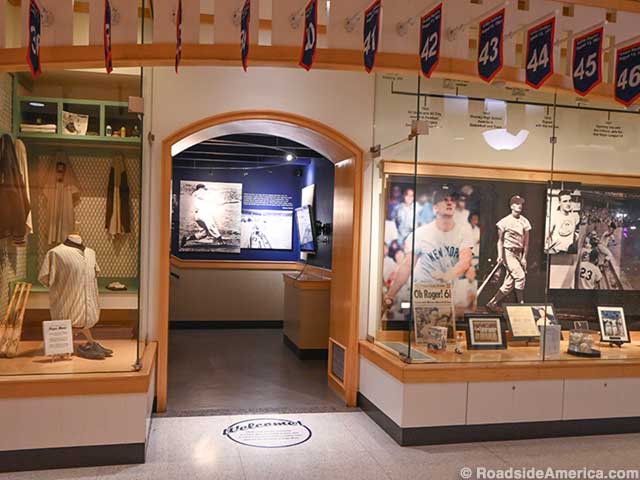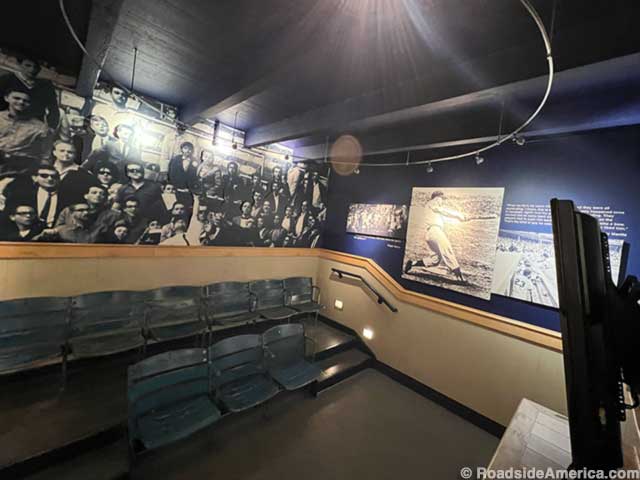
Roger, a shy man, had to wear this crown for press photos.
Roger Maris Museum
Fargo, North Dakota
Roger Maris was an outfielder for the New York Yankees. In 1961 he became "Baseball's Single-Season Home Run King," the only player in the major leagues -- at that time -- to ever hit 61 home runs in a season; one more than Babe Ruth, who hit 60 in 1927.
This would seem to be a worthy and clear-cut claim to fame -- except that Ruth hit his 60 in a 154-game season, while Maris hit his 61 in a 162-game season. And 1961 was an uncharacteristically productive year for Roger Maris. Babe Ruth went on to hit nearly 300 more home runs in his baseball career. Roger did not. Babe Ruth was inducted into the Baseball Hall of Fame. Roger was not. He was a good ballplayer, but his power stroke faded, he was traded to St. Louis, and seven years after his record-setting season he was out of baseball and running a beer distributorship in Florida.
Fargo -- Roger's home town from the time he was ten years old -- loved him nonetheless. In 1984 a delegation from its American Legion asked the Single-Season Home Run King if he would agree to donate his memorabilia to a local museum. Roger agreed, but -- perhaps familiar with the dozens of obscure pioneer heritage museums that dot North Dakota -- insisted that his museum be where a large number of people could see it. The American Legion put their heads together and came up with a practical, some might even say brilliant, solution. They put Roger's museum in a mall.

Pennants near the ceiling list the dates of each of Roger's 61 home runs in 1961.
The West Acres World Shopping Center is the biggest in Fargo and the largest in the U.S. between Minneapolis and the Pacific Ocean (according to its promotional literature). The museum has a perpetual lease there.
When we visited during the summer of 2022, the mall was bustling, busy -- like a venerable ballpark still able to fill seats, defying shop-at-homers and mall shut-out trends. But we had the museum to ourselves. The Maris exhibits run 72 feet behind glass along one side of an indoor corridor from the parking lot. A pocket video theater with authentic 1960s Yankee Stadium seats plays footage of Roger. Small pennants above the exhibit wall list the days on which Roger hit each of his 61 home runs, while other displays strive to show him as something more than the Single-Season Home Run King.

Pocket video theater entrance. To the left, a replica of Roger's locker.
One exhibit notes that Roger was "a complete athlete" and calls attention to his 39 homers and Gold Glove award in 1960. His "Babe Ruth Sultan of Swat Award" crowns from 1960 and 1961 are highlights, as are his 60th (but not his 61st) home run baseball and his picture on the Wheaties 60th (but not its 61st) anniversary box. There are bats, trophies, plaques, jerseys, and baseball cards, a framed painting of Roger in his Yankee uniform staring off toward the horizon (possibly at one of his 61 home runs), magazines and newspapers featuring his picture, and a replica of his Yankee Stadium locker.

Viewers in the video theater sit in 1960s Yankee Stadium seats.
Despite these efforts, the museum's abundance of awards from 1961 only makes the absence of those from other years more apparent -- and the disparity was made worse when some creep broke into the displays in July 2016 and stole one of Roger's trophy belts and his 1960 American League Most Valuable Player Award.
Roger's 61 home runs were surpassed several times from 1998 through 2001, in what was called the "steroid era" of professional baseball. But those players' suspected use of performance-enhancing drugs made their records questionable, and for for many baseball fans Roger Maris remained the Single-Season Home Run King -- until 2022, when Aaron Judge (also of the Yankees), hit an untainted 62 homers (also in a 162-game season).
Roger was notoriously press-shy and once said, "I never wanted all this hoopla." He died of cancer less than 18 months after the museum opened. He is buried only a couple of miles away. He was 51.





